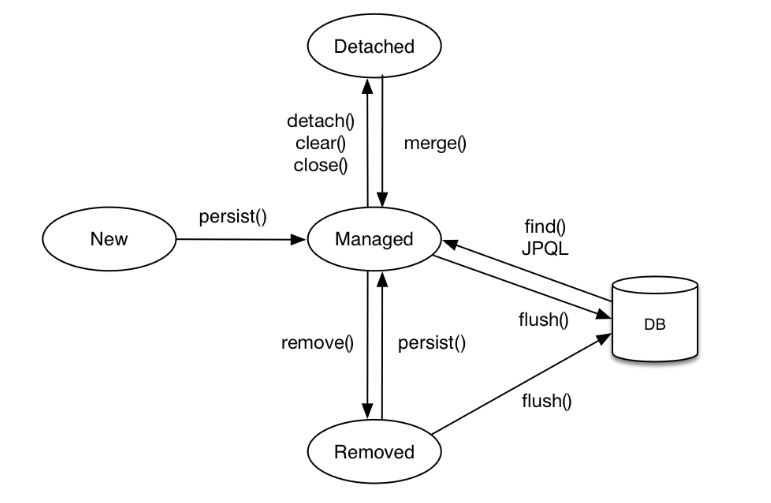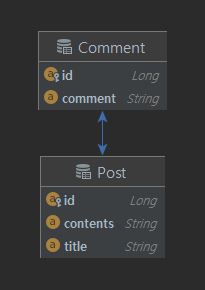CascadeType in JPA
RECOMMEND POSTS BEFORE THIS
1. Entity Lifecycle
JPA(Java Persistence API)의 CascadeType를 정리하기 전에 엔티티 라이프사이클(entity lifecycle)를 먼저 살펴보겠습니다.
- 비영속(new/transient)
- 엔티티 객체를 새로 생성하였지만 엔티티 매니저(entity manager)에 의해 관리되고 있지 않는 상태입니다.
- 엔티티 객체가 영속성 컨텍스트와 전혀 관계가 없는 상태입니다.
- 영속(managed)
- 엔티티 객체가 엔티티 매니저에 의해 관리되고 있는 상태입니다.
- 엔티티 객체가 영속성 컨텍스트에 저장되어 상태입니다.
- persist(E) 메소드를 통해 영속성 컨텍스트에 저장됩니다.
- 준영속(detached)
- 엔티티 객체가 영속성 컨텍스트에서 분리된 상태입니다.
- 엔티티 객체가 영속성 컨텍스트에서 분리된 상태이므로 엔티티 매니저는 객체의 변화를 감지하지 못합니다.
- detach(E) 메소드를 통해 영속성 컨텍스트에서 분리됩니다.
- 삭제(removed)
- 엔티티 객체를 영속성 컨텍스트에서 삭제하는 행위입니다.
- remove(E) 메소드를 통해 영속성 컨텍스트에서 삭제됩니다.

2. Cascade in JPA
JPA에서 Casecade는 영속성이 전이를 위해 사용합니다.
영속성 전이는 엔티티의 영속성 상태 변화를 연관된 엔티티에도 함께 적용하는 것이다. 예를 들어, 엔티티를 저장할 때 연관된 엔티티도 함께 저장하고, 엔티티를 삭제할 때 연관된 엔티티도 함께 삭제하는 것이 영속성 전이이다.
엔티티들 사이의 관계는 @OneToOne, @OneToMany, @ManyToOne, @ManyToMany 애너테이션을 사용하여 정의합니다.
이 애너테이션들의 cascade 속성(attribute)를 사용하면 연관 관계가 맺어진 엔티티들 사이의 전이 여부와 시점을 지정할 수 있습니다.
다음은 각 CascadeType에 따라 영속성 전이가 이루어지는 시점입니다.
- PERSIST
- 엔티티 객체가
new상태에서managed상태로 변경되는 시점
- 엔티티 객체가
- REMOVE
- 엔티티 객체가
managed상태에서removed상태로 변경되는 시점
- 엔티티 객체가
- DETACH
- 엔티티 객체가
managed상태에서detached상태로 변경되는 시점
- 엔티티 객체가
- MERGE
- 엔티티 객체가
detached상태에서managed상태로 변경되는 시점
- 엔티티 객체가
- REFRESH
- 엔티티 매니저의 refresh(E) 메소드 호출 시점
- ALL
- 모든 상태 변화에 대해 종속된 엔티티들의 영속 상태를 함께 반영
3. Practice
간단한 테스트 코드를 통해 실습하기 전 위 내용을 간략하게 정리해보면 다음과 같습니다.
- 특정 엔티티 객체의 영속 상태가 변경될 때 종속된 엔티티 객체들도 함께 반영되는 것을 영속성 전이라고 한다.
- JPA는 관계를 맺는 애너테이션을 사용해 영속성 전이를 일으킬 수 있다.
- 영속성 전이가 일어나는 시점은
CascadeType으로 지정할 수 있다.
3.1. Entity Relationship Diagram
- 부모 엔티티는
Post클래스입니다. - 종속된 엔티티는
Comment클래스입니다.

3.2. Entities
- Post 클래스입니다.
- @OneToMany 애너테이션의 cascade 속성을 사용해 영속성 전이 시점을 바꿔가면서 테스트합니다.
package blog.in.action.cascade.entity;
import lombok.AllArgsConstructor;
import lombok.Builder;
import lombok.Getter;
import lombok.NoArgsConstructor;
import jakarta.persistence.*;
import java.util.List;
@Builder
@Getter
@AllArgsConstructor
@NoArgsConstructor
@Entity
public class Post {
@Id
@GeneratedValue
private long id;
@Column
private String content;
@OneToMany(cascade = {})
private List<Comment> comments;
}
- Comment 클래스입니다.
package blog.in.action.cascade.entity;
import jakarta.persistence.Column;
import jakarta.persistence.Entity;
import jakarta.persistence.GeneratedValue;
import jakarta.persistence.Id;
import lombok.*;
@Builder
@Getter
@NoArgsConstructor
@AllArgsConstructor
@Entity
public class Comment {
@Id
@GeneratedValue
private long id;
@Setter
@Column
private String content;
}
3.3. CascadeType.PERSIST
- 다음과 같이 Post 클래스를 변경합니다.
@OneToMany(cascade = {CascadeType.PERSIST})
private List<Comment> commentList;
- Post 엔티티와 Comment 엔티티 객체를 생성합니다.
- 두 엔티티 객체를 연결합니다.
- persit(E) 메소드를 통해 영속성 컨텍스트에 저장합니다.
- 영속성 컨텍스트 내용을 데이터베이스에 반영하고 비웁니다.
- 데이터베이스에 데이터가 저장되었는지 확인합니다.
package blog.in.action.cascade;
import blog.in.action.cascade.entity.Comment;
import blog.in.action.cascade.entity.Post;
import jakarta.persistence.PersistenceContext;
import org.junit.jupiter.api.Test;
import org.springframework.boot.test.autoconfigure.orm.jpa.DataJpaTest;
import jakarta.persistence.EntityManager;
import java.util.Collections;
import static org.hamcrest.MatcherAssert.assertThat;
import static org.hamcrest.Matchers.equalTo;
@DataJpaTest
public class PersistTest {
@PersistenceContext
private EntityManager sut;
@Test
public void cascade_when_persist() {
var comment = Comment.builder()
.content("This is comment")
.build();
var comments = Collections.singletonList(comment);
var post = Post.builder()
.content("Hello World")
.comments(comments)
.build();
sut.persist(post);
sut.flush();
sut.clear();
var postId = post.getId();
var commentId = comment.getId();
var resultPost = sut.find(Post.class, postId);
var resultComment = sut.find(Comment.class, commentId);
assertThat(resultPost.getContent(), equalTo("Hello World"));
assertThat(resultComment.getContent(), equalTo("This is comment"));
}
}
Result Log
- Post, Comment 엔티티 모두 데이터베이스에 삽입(insert)됩니다.
- 중간 매핑(mapping)을 위한 post_comments 테이블에 데이터가 삽입됩니다.
Hibernate: select next value for post_seq
Hibernate: select next value for comment_seq
Hibernate: insert into post (content,id) values (?,?)
Hibernate: insert into comment (content,id) values (?,?)
Hibernate: insert into post_comments (post_id,comments_id) values (?,?)
Hibernate: select p1_0.id,p1_0.content from post p1_0 where p1_0.id=?
Hibernate: select c1_0.id,c1_0.content from comment c1_0 where c1_0.id=?
3.4. CascadeType.REMOVE
- 다음과 같이 Post 클래스를 변경합니다.
@OneToMany(cascade = {CascadeType.REMOVE})
private List<Comment> comments;
- beforeEach 메소드를 통해 테스트 실행 전 데이터를 미리 삽입합니다
- Post 엔티티 객체를 조회합니다.
- remove(E) 메소드를 사용해 영속성 컨텍스트에서 제거합니다.
- 데이터베이스를 다시 조회했을 때 데이터가 없을 것으로 예상합니다.
package blog.in.action.cascade;
import blog.in.action.cascade.entity.Comment;
import blog.in.action.cascade.entity.Post;
import java.util.ArrayList;
import java.util.Collections;
import java.util.List;
import jakarta.persistence.*;
import lombok.extern.log4j.Log4j2;
import org.junit.jupiter.api.BeforeEach;
import org.junit.jupiter.api.Test;
import org.springframework.boot.test.autoconfigure.orm.jpa.DataJpaTest;
import org.springframework.boot.test.context.SpringBootTest;
import static org.hamcrest.MatcherAssert.assertThat;
import static org.hamcrest.Matchers.equalTo;
@DataJpaTest
public class RemoveTest {
@PersistenceContext
private EntityManager sut;
@BeforeEach
public void beforeEach() {
var comment = Comment.builder()
.content("This is comment")
.build();
var comments = Collections.singletonList(comment);
var post = Post.builder()
.content("Hello World")
.comments(comments)
.build();
sut.persist(post);
sut.persist(comment);
sut.flush();
sut.clear();
}
@Test
public void cascade_when_remove() {
String findByContent = "SELECT p FROM Post p where p.content = ?1";
TypedQuery<Post> selectQuery = sut.createQuery(findByContent, Post.class);
selectQuery.setParameter(1, "Hello World");
var post = selectQuery.getSingleResult();
var postId = post.getId();
var commentId = post.getComments()
.get(0)
.getId();
sut.remove(post);
sut.flush();
sut.clear();
var resultPost = sut.find(Post.class, postId);
var resultComment = sut.find(Comment.class, commentId);
assertThat(resultPost == null, equalTo(true));
assertThat(resultComment == null, equalTo(true));
}
}
Result Log
- Post 엔티티 객체를 영속성 컨테이너에서 제거함으로써 Comment 엔티티 객체도 함께 삭제되는 것을 확인할 수 있습니다.
- 두 엔티티를 연결하는 매핑 테이블, Comment 테이블, Post 테이블 순으로 데이터가 삭제됩니다.
Hibernate: select next value for post_seq
Hibernate: select next value for comment_seq
Hibernate: insert into post (content,id) values (?,?)
Hibernate: insert into comment (content,id) values (?,?)
Hibernate: insert into post_comments (post_id,comments_id) values (?,?)
Hibernate: select p1_0.id,p1_0.content from post p1_0 where p1_0.content=?
Hibernate: select c1_0.post_id,c1_1.id,c1_1.content from post_comments c1_0 join comment c1_1 on c1_1.id=c1_0.comments_id where c1_0.post_id=?
Hibernate: delete from post_comments where post_id=?
Hibernate: delete from comment where id=?
Hibernate: delete from post where id=?
Hibernate: select p1_0.id,p1_0.content from post p1_0 where p1_0.id=?
Hibernate: select c1_0.id,c1_0.content from comment c1_0 where c1_0.id=?
3.5. CascadeType.DETACH
- 다음과 같이 Post 클래스를 변경합니다.
@OneToMany(cascade = {CascadeType.DETACH})
private List<Comment> comments;
- beforeEach 메소드를 통해 테스트 실행 전 데이터를 미리 삽입합니다
- Post 엔티티 객체를 조회합니다.
- Comment 엔티티 객체의 상태를 변경합니다.
- Post 엔티티 객체를 detach(E) 메소드를 사용해 영속성 컨텍스트가 관리하지 않는 상태로 변경합니다.
- Comment 엔티티 객체의 상태 변경에 대한 오염 감지(dirty checking)이 동작하지 않을 것을 예상합니다.
package blog.in.action.cascade;
import blog.in.action.cascade.entity.Comment;
import blog.in.action.cascade.entity.Post;
import jakarta.persistence.EntityManager;
import jakarta.persistence.PersistenceContext;
import jakarta.persistence.TypedQuery;
import org.junit.jupiter.api.BeforeEach;
import org.junit.jupiter.api.Test;
import org.springframework.boot.test.autoconfigure.orm.jpa.DataJpaTest;
import java.util.Collections;
import static org.hamcrest.MatcherAssert.assertThat;
import static org.hamcrest.Matchers.equalTo;
@DataJpaTest
public class DetachTest {
@PersistenceContext
private EntityManager sut;
@BeforeEach
public void beforeEach() {
var comment = Comment.builder()
.content("This is comment")
.build();
var comments = Collections.singletonList(comment);
var post = Post.builder()
.content("Hello World")
.comments(comments)
.build();
sut.persist(post);
sut.persist(comment);
sut.flush();
sut.clear();
}
@Test
public void cascade_when_detach() {
String findByContent = "SELECT p FROM Post p where p.content = ?1";
TypedQuery<Post> selectQuery = sut.createQuery(findByContent, Post.class);
selectQuery.setParameter(1, "Hello World");
var post = selectQuery.getSingleResult();
var comment = post.getComments().get(0);
var commentId = comment.getId();
comment.setContent("This is new comment");
sut.detach(post);
sut.flush();
sut.clear();
var resultComment = sut.find(Comment.class, commentId);
assertThat(resultComment.getContent(), equalTo("This is comment"));
}
}
Result Log
- Post 엔티티 객체를 준영속 상태로 변경하였기 때문에 Comment 엔티티 객체도 함께 준영속 상태가 됩니다.
- Comment 엔티티 객체의 상태 변경이 데이터베이스에 반영되지 않습니다.
- detach(E) 메소드 실행 라인을 주석하면 오염 감지가 수행되어 값이 변경됩니다.
Hibernate: select next value for post_seq
Hibernate: select next value for comment_seq
Hibernate: insert into post (content,id) values (?,?)
Hibernate: insert into comment (content,id) values (?,?)
Hibernate: insert into post_comments (post_id,comments_id) values (?,?)
Hibernate: select p1_0.id,p1_0.content from post p1_0 where p1_0.content=?
Hibernate: select c1_0.post_id,c1_1.id,c1_1.content from post_comments c1_0 join comment c1_1 on c1_1.id=c1_0.comments_id where c1_0.post_id=?
Hibernate: select c1_0.id,c1_0.content from comment c1_0 where c1_0.id=?
3.6. CascadeType.MERGE
- 다음과 같이 Post 클래스를 변경합니다.
@OneToMany(cascade = {CascadeType.MERGE})
private List<Comment> comments;
- beforeEach 메소드를 통해 테스트 실행 전 데이터를 미리 삽입합니다
- Post 엔티티 객체를 조회합니다.
- Post, Comment 엔티티 객체를 detach(E) 메소드를 사용해 영속성 컨텍스트가 관리하지 않는 상태로 변경합니다.
- Comment 엔티티 객체의 상태를 변경하고 Post 엔티티 객체만 영속성 컨텍스트가 관리하는 상태로 다시 변경합니다.
- Comment 엔티티 객체 상태 변경에 대한 오염 감지를 통해 데이터베이스 상태가 변경됨을 기대합니다.
package blog.in.action.cascade;
import blog.in.action.cascade.entity.Comment;
import blog.in.action.cascade.entity.Post;
import jakarta.persistence.EntityManager;
import jakarta.persistence.PersistenceContext;
import jakarta.persistence.TypedQuery;
import org.junit.jupiter.api.BeforeEach;
import org.junit.jupiter.api.Test;
import org.springframework.boot.test.autoconfigure.orm.jpa.DataJpaTest;
import java.util.Collections;
import static org.hamcrest.MatcherAssert.assertThat;
import static org.hamcrest.Matchers.equalTo;
@DataJpaTest
public class MergeTest {
@PersistenceContext
private EntityManager sut;
@BeforeEach
public void beforeEach() {
var comment = Comment.builder()
.content("This is comment")
.build();
var comments = Collections.singletonList(comment);
var post = Post.builder()
.content("Hello World")
.comments(comments)
.build();
sut.persist(post);
sut.persist(comment);
sut.flush();
sut.clear();
}
@Test
public void cascade_when_merge() {
String findByContent = "SELECT p FROM Post p where p.content = ?1";
TypedQuery<Post> selectQuery = sut.createQuery(findByContent, Post.class);
selectQuery.setParameter(1, "Hello World");
var post = selectQuery.getSingleResult();
var comment = post.getComments().get(0);
var commentId = comment.getId();
sut.detach(post);
sut.detach(comment);
comment.setContent("This is new comment");
sut.merge(post);
sut.flush();
sut.clear();
var resultComment = sut.find(Comment.class, commentId);
assertThat(resultComment.getContent(), equalTo("This is new comment"));
}
}
Result Log
- Comment 엔티티 객체의 상태 변경으로 인해 오염 감지 기능이 동작합니다.
- update comment set content=? where id=?
Hibernate: select next value for post_seq
Hibernate: select next value for comment_seq
Hibernate: insert into post (content,id) values (?,?)
Hibernate: insert into comment (content,id) values (?,?)
Hibernate: insert into post_comments (post_id,comments_id) values (?,?)
Hibernate: select p1_0.id,p1_0.content from post p1_0 where p1_0.content=?
Hibernate: select c1_0.post_id,c1_1.id,c1_1.content from post_comments c1_0 join comment c1_1 on c1_1.id=c1_0.comments_id where c1_0.post_id=?
Hibernate: select p1_0.id,c1_0.post_id,c1_1.id,c1_1.content,p1_0.content from post p1_0 left join (post_comments c1_0 join comment c1_1 on c1_1.id=c1_0.comments_id) on p1_0.id=c1_0.post_id where p1_0.id=?
Hibernate: update comment set content=? where id=?
Hibernate: select c1_0.id,c1_0.content from comment c1_0 where c1_0.id=?
4.5. CascadeType.REFRESH
- 다음과 같이 Post 클래스를 변경합니다.
@OneToMany(cascade = {CascadeType.REFRESH})
private List<Comment> comments;
- beforeEach 메소드를 통해 테스트 실행 전 데이터를 미리 삽입합니다
- Post 엔티티 객체를 조회합니다.
- Post, Comment 엔티티 객체를 미리 영속성 컨텍스트에서 관리합니다.
- 업데이트 쿼리를 통해 Comment 테이블의 데이터를 직접 변경합니다.
- refresh(E) 메소드를 통해 영속성 컨테이너 내부의 Post 엔티티 객체와 데이터베이스를 동기화합니다.
- 미리 조회한 Comment 엔티티 객체의 상태가 데이터베이스와 동일한 것을 기대합니다.
package blog.in.action.cascade;
import blog.in.action.cascade.entity.Comment;
import blog.in.action.cascade.entity.Post;
import jakarta.persistence.EntityManager;
import jakarta.persistence.PersistenceContext;
import jakarta.persistence.Query;
import jakarta.persistence.TypedQuery;
import org.hamcrest.MatcherAssert;
import org.junit.jupiter.api.BeforeEach;
import org.junit.jupiter.api.Test;
import org.springframework.boot.test.autoconfigure.orm.jpa.DataJpaTest;
import java.util.Collections;
import static org.hamcrest.Matchers.equalTo;
@DataJpaTest
public class RefreshTest {
@PersistenceContext
private EntityManager sut;
@BeforeEach
public void beforeEach() {
var comment = Comment.builder()
.content("This is comment")
.build();
var comments = Collections.singletonList(comment);
var post = Post.builder()
.content("Hello World")
.comments(comments)
.build();
sut.persist(post);
sut.persist(comment);
sut.flush();
sut.clear();
}
@Test
public void cascade_when_refresh() {
String findByContent = "SELECT p FROM Post p where p.content = ?1";
TypedQuery<Post> selectQuery = sut.createQuery(findByContent, Post.class);
selectQuery.setParameter(1, "Hello World");
var post = selectQuery.getSingleResult();
var comment = post.getComments().get(0);
var commentId = comment.getId();
String updateComment = "UPDATE Comment c SET c.content = 'This is new comment' where c.id = ?1";
Query updateQuery = sut.createQuery(updateComment);
updateQuery.setParameter(1, commentId);
updateQuery.executeUpdate();
sut.refresh(post);
MatcherAssert.assertThat(comment.getContent(), equalTo("This is new comment"));
}
}
Result Log
- refresh(E) 메소드를 통해 영속성 컨테이너와 데이터베이스를 동기화합니다.
- select c1_0.id,c1_0.content from comment c1_0 where c1_0.id=?
- select p1_0.id,c1_0.post_id,c1_1.id,c1_1.content,p1_0.content from post p1_0 left join (post_comments c1_0 join comment c1_1 on c1_1.id=c1_0.comments_id) on p1_0.id=c1_0.post_id where p1_0.id=?
- 미리 조회한 Comment 엔티티 객체를 직접 동기화하지 않았음에도 데이터베이스와 동일한 데이터를 가지는 것을 알 수 있습니다.
- Post 엔티티 객체를 동기화하는 코드 라인을 주석하면 테스트가 실패합니다.
Hibernate: select next value for post_seq
Hibernate: select next value for comment_seq
Hibernate: insert into post (content,id) values (?,?)
Hibernate: insert into comment (content,id) values (?,?)
Hibernate: insert into post_comments (post_id,comments_id) values (?,?)
Hibernate: select p1_0.id,p1_0.content from post p1_0 where p1_0.content=?
Hibernate: select c1_0.post_id,c1_1.id,c1_1.content from post_comments c1_0 join comment c1_1 on c1_1.id=c1_0.comments_id where c1_0.post_id=?
Hibernate: update comment set content='This is new comment' where id=?
Hibernate: select c1_0.id,c1_0.content from comment c1_0 where c1_0.id=?
Hibernate: select p1_0.id,c1_0.post_id,c1_1.id,c1_1.content,p1_0.content from post p1_0 left join (post_comments c1_0 join comment c1_1 on c1_1.id=c1_0.comments_id) on p1_0.id=c1_0.post_id where p1_0.id=?
CLOSING
영속성 전이에 대해 공부하면서 고아(Orphan) 객체라는 개념을 접했습니다.
관련된 내용을 메모해두고 다음 포스트에 정리해보겠습니다.
부모 엔티티와 연관관계가 끊어진 자식 엔티티를 자동으로 삭제 하는 기능을 고아 객체 라고 합니다.

댓글남기기